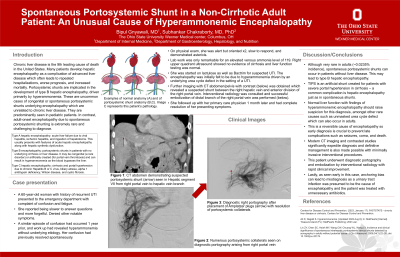Tuesday Poster Session
Category: Liver
P4783 - Spontaneous Portosystemic Shunt in a Non-Cirrhotic Adult Patient
Tuesday, October 29, 2024
10:30 AM - 4:00 PM ET
Location: Exhibit Hall E

Has Audio
- BG
Bipul Gnyawali, MD
The Ohio State University Wexner Medical Center
Philadelphia, PA
Presenting Author(s)
Award: Presidential Poster Award
Bipul Gnyawali, MD1, Subhankar Chakraborty, MD, PhD2
1The Ohio State University Wexner Medical Center, Philadelphia, PA; 2The Ohio State University Wexner Medical Center, Columbus, OH
Introduction: Chronic liver disease ranks as the 9th leading cause of death in the U.S. Many patients develop hepatic encephalopathy (HE) due to advanced liver disease, leading to frequent hospitalizations, worse prognosis, and higher mortality. Portosystemic shunts contribute to type B HE in end-stage liver disease. However, congenital or spontaneous portosystemic shunts, causing encephalopathy without chronic liver disease, are rare, mostly occurring in pediatric patients. Adult-onset encephalopathy due to spontaneous portosystemic shunting is extremely rare and challenging to diagnose.
Case Description/Methods: A 60-year-old woman with no significant medical history presented to the emergency department with confusion and fatigue. She noted slower responses and increased forgetfulness. Despite a history of intermittent dysuria, she reported no symptoms at presentation and denied other significant issues. A similar episode occurred a year prior, revealing hyperammonemia without a clear cause, which resolved spontaneously. On examination, she was alert but oriented to two spheres, slow to respond, and showed asterixis. Lab work showed elevated venous ammonia at 119 µmol/L, but right upper quadrant ultrasound showed no cirrhosis. Liver panel was unremarkable: total bilirubin 1.2 mg/dL, ALP 139 U/L, AST 32 U/L, and ALT 24 U/L. She started lactulose and Bactrim for a suspected urinary tract infection (UTI). Initial encephalopathy was thought to be hyperammonemia due to a urea cycle defect exacerbated by UTI. Further imaging with CT abdomen/pelvis showed a suspected shunt between the right hepatic vein and the anterior division of the right portal vein. Interventional radiology successfully embolized the distal branch of the right portal vein. One month later, her confusion had resolved.
Discussion: Although rare in adults, spontaneous portosystemic shunts can occur without liver disease. Transjugular intrahepatic portosystemic shunts (TIPS) are artificial shunts for severe portal hypertension in cirrhosis, often causing HE similar to spontaneous shunts. Normal liver function with hyperammonemic encephalopathy should raise suspicion for spontaneous shunts, a reversible etiology. Early diagnosis is crucial to prevent complications like seizures, coma, and death. Modern CT imaging expedites diagnosis, and minimally invasive interventional procedures offer definitive management. This case also highlights the risk of anchoring bias, as the initial misdiagnosis of UTI led to unnecessary antibiotic treatment.
Disclosures:
Bipul Gnyawali, MD1, Subhankar Chakraborty, MD, PhD2. P4783 - Spontaneous Portosystemic Shunt in a Non-Cirrhotic Adult Patient, ACG 2024 Annual Scientific Meeting Abstracts. Philadelphia, PA: American College of Gastroenterology.
Bipul Gnyawali, MD1, Subhankar Chakraborty, MD, PhD2
1The Ohio State University Wexner Medical Center, Philadelphia, PA; 2The Ohio State University Wexner Medical Center, Columbus, OH
Introduction: Chronic liver disease ranks as the 9th leading cause of death in the U.S. Many patients develop hepatic encephalopathy (HE) due to advanced liver disease, leading to frequent hospitalizations, worse prognosis, and higher mortality. Portosystemic shunts contribute to type B HE in end-stage liver disease. However, congenital or spontaneous portosystemic shunts, causing encephalopathy without chronic liver disease, are rare, mostly occurring in pediatric patients. Adult-onset encephalopathy due to spontaneous portosystemic shunting is extremely rare and challenging to diagnose.
Case Description/Methods: A 60-year-old woman with no significant medical history presented to the emergency department with confusion and fatigue. She noted slower responses and increased forgetfulness. Despite a history of intermittent dysuria, she reported no symptoms at presentation and denied other significant issues. A similar episode occurred a year prior, revealing hyperammonemia without a clear cause, which resolved spontaneously. On examination, she was alert but oriented to two spheres, slow to respond, and showed asterixis. Lab work showed elevated venous ammonia at 119 µmol/L, but right upper quadrant ultrasound showed no cirrhosis. Liver panel was unremarkable: total bilirubin 1.2 mg/dL, ALP 139 U/L, AST 32 U/L, and ALT 24 U/L. She started lactulose and Bactrim for a suspected urinary tract infection (UTI). Initial encephalopathy was thought to be hyperammonemia due to a urea cycle defect exacerbated by UTI. Further imaging with CT abdomen/pelvis showed a suspected shunt between the right hepatic vein and the anterior division of the right portal vein. Interventional radiology successfully embolized the distal branch of the right portal vein. One month later, her confusion had resolved.
Discussion: Although rare in adults, spontaneous portosystemic shunts can occur without liver disease. Transjugular intrahepatic portosystemic shunts (TIPS) are artificial shunts for severe portal hypertension in cirrhosis, often causing HE similar to spontaneous shunts. Normal liver function with hyperammonemic encephalopathy should raise suspicion for spontaneous shunts, a reversible etiology. Early diagnosis is crucial to prevent complications like seizures, coma, and death. Modern CT imaging expedites diagnosis, and minimally invasive interventional procedures offer definitive management. This case also highlights the risk of anchoring bias, as the initial misdiagnosis of UTI led to unnecessary antibiotic treatment.
Disclosures:
Bipul Gnyawali indicated no relevant financial relationships.
Subhankar Chakraborty indicated no relevant financial relationships.
Bipul Gnyawali, MD1, Subhankar Chakraborty, MD, PhD2. P4783 - Spontaneous Portosystemic Shunt in a Non-Cirrhotic Adult Patient, ACG 2024 Annual Scientific Meeting Abstracts. Philadelphia, PA: American College of Gastroenterology.

